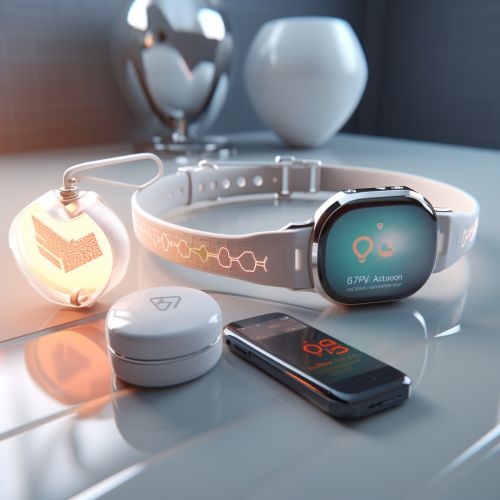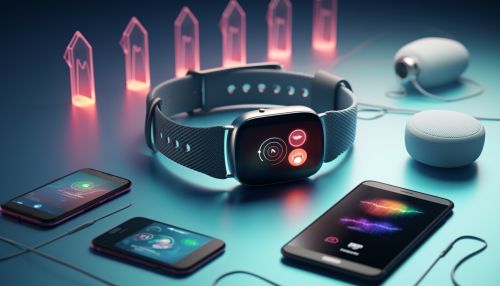Wearable Technology in Health Monitoring
Introduction
Wearable technology in health monitoring refers to electronic devices that are worn on the body, either as an accessory or as part of the material used in clothing. These devices, known as wearables, are hands-free gadgets with practical uses, powered by microprocessors and enhanced with the ability to send and receive data via the InternetInternet Technology. They are capable of tracking information related to health and fitness on a real-time basis.
History
The concept of wearable technology in health monitoring has its roots in the early 20th century. One of the first wearable devices was a portable EKG monitor, developed in the 1960s. However, the real breakthrough came with the advent of microprocessors in the 1970s, which enabled the miniaturization of electronic devices. This led to the development of wearable heart rate monitors in the 1980s, followed by the introduction of wireless connectivity in the 1990s, which allowed for the remote monitoring of patients' healthHealth Monitoring Systems.
Types of Wearable Technology in Health Monitoring
There are several types of wearable technology devices that are used in health monitoring. These include:
- Fitness Trackers: These devices, such as the Fitbit or the Jawbone UP, track health-related data such as steps taken, calories burned, and sleep patterns. They are often paired with a smartphone app for data collection and analysis.
- Smart Watches: These devices, like the Apple Watch or the Samsung Gear, offer all the features of fitness trackers but with additional capabilities, such as the ability to receive messages and calls, provide GPS coordinates, and even pay for goods and services.
- Body Sensors: These are specialized devices that monitor specific health parameters. For example, the Zephyr BioHarness is a wearable biofeedback device that monitors heart rate, breathing rate, and body temperature.
- Smart Clothing: This category includes items like sensor-equipped socks that monitor foot pressure for diabetics, shirts that track heart rate and breathing patterns, and sports bras that monitor workout intensity.


Applications of Wearable Technology in Health Monitoring
Wearable technology has a wide range of applications in health monitoring. Some of the key applications include:
- Fitness and Wellness: Wearable devices are commonly used to track physical activity and diet, helping users to maintain a healthy lifestyle. They can also provide feedback on sleep patterns and stress levels, helping users to improve their overall wellness.
- Chronic Disease Management: Wearable devices can help in the management of chronic diseases such as diabetes and heart disease by continuously monitoring vital signs and alerting users to potential health issues.
- Elderly Care: Wearable technology can help to monitor the health and safety of the elderly, alerting caregivers to potential issues such as falls or changes in vital signs.
- Rehabilitation: Wearable devices can assist in the rehabilitation of patients recovering from injuries or surgeries by tracking progress and providing feedback to healthcare providers.
- Clinical Trials: Wearable technology can be used in clinical trials to collect patient data, improving the efficiency and accuracy of data collection.
Challenges and Future Directions
Despite the potential benefits, there are several challenges associated with the use of wearable technology in health monitoring. These include issues related to data privacy and security, device accuracy, user adherence, and the integration of data into healthcare systems. Furthermore, there is a need for further research to establish the clinical validity and utility of these devices.
Looking ahead, the future of wearable technology in health monitoring is promising. Advances in technology, such as the development of more sophisticated sensors and the integration of artificial intelligence, are expected to drive the growth of this field. Moreover, as the healthcare industry continues to shift towards a more patient-centered and preventative care model, the demand for wearable technology is likely to increase.
